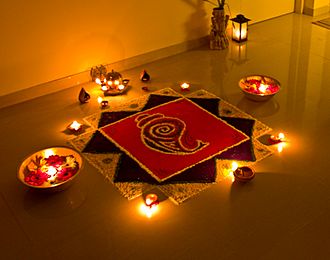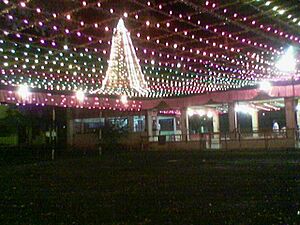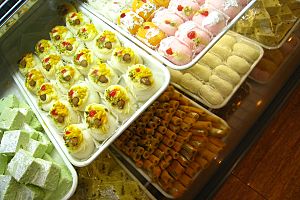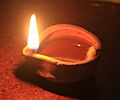Diwali facts for kids
Quick facts for kids Diwali / Deepavali |
|
|---|---|

Rangoli decorations, made using colored powder, are popular during Diwali
|
|
| Also called | Deepavali |
| Observed by | Hindus, Sikhs, Jains, and Buddhists |
| Type | Indian, Cultural, Seasonal |
| Celebrations | Diya and lighting, home decoration, shopping, fireworks, puja (prayers), gifts, performing religious rituals, feast, and sweets |
| Begins | Dhanteras, 2 days before Diwali |
| Ends | Bhai Dooj, 2 days after Diwali |
| Date | Varies per Hindu Lunisolar calendar |
| 2024 date | November 1 |
| 2025 date | October 20 |
| Related to | Kali Puja, Diwali (Jainism), Bandi Chhor Divas |
Diwali, also known as Deepavali or Deepawali, is one of India's biggest and most important festivals. The name Deepawali means "rows of lighted lamps." It is a festival of lights, and Hindu people celebrate it with great happiness. During this festival, people light up their houses and shops with Diyas (small oil lamps made from clay). They also pray to Lord Ganesha for good luck and Goddess Lakshmi for wealth and wisdom.
This festival happens in the Hindu month of Kartika, usually in October or November. In many parts of India, Deepawali is celebrated for five days. Hindus see it as a celebration of life and a time to make family bonds stronger. In some areas, it even marks the start of a new year! Before the festival, people clean and decorate their homes. They also create beautiful and colorful rangoli designs on their floors.
Deepawali is a public holiday in many countries like Nepal, Sri Lanka, Singapore, Malaysia, Mauritius, Fiji, Suriname, Guyana, and Trinidad and Tobago. It is also a school holiday in some states of the United States where many Hindu families live. The first celebration of Diwali at the White House was held by President George W. Bush.
What is Diwali?
Diwali is a five-day festival in many parts of India. The main Diwali night happens on the new moon, which is the darkest night of autumn. The festival takes place at the end of the Hindu lunar month of Ashvin and the beginning of Kartika. This is usually in late October or early November on the Gregorian calendar. The night shines brightly with diyas, candles, and lanterns. The sounds of fireworks and the sights of rangoli designs make the night truly special. It's also a time for delicious food, with big feasts and many mithai (candies and desserts). Diwali brings families and friends together every year, making it a festival of joy and togetherness.
Preparations for Diwali often start days or even weeks before the festival. The official celebrations begin two days before the main Diwali night and end two days after it. Each of these five days has its own special meaning and traditions.
- Day 1 - Dhanteras: This day celebrates the birthdays of Lakshmi, the goddess of wealth, and Dhanvantari, the god of health. Dhanvantari is linked to Ayurveda, a type of natural healing. People clean and decorate their homes and offices. They arrange lights everywhere. Many also buy gold and silver jewelry on this day.
- Day 2 - Naraka Chaturdasi: On this day, people celebrate Goddess Kali and Lord Krishna's victory over the demon Narakasura. This victory freed the world from fear. In some areas, people take special fragrant oil baths. They might also do small pujas (prayers). Women often decorate their hands with beautiful henna designs. Families are also busy making homemade sweets for the main Diwali celebration.
- Day 3 - Lakshmi Puja: This is the most important day of the festival. As evening comes, people put on their new or best clothes. Then, diyas are lit, and prayers are offered to Lakshmi. People ask for her blessings for a good year ahead. They open their doors and windows to welcome her. After the puja, people go outside and light patakhe (fireworks). Afterward, they return for a family feast, conversations, and mithai.
- Day 4 - Padwa, Balipratipada: Padwa is celebrated differently across India. In Northern Indian states, people worship their instruments, arms, and equipment. This day also celebrates the love between a wife and husband. Husbands often give special gifts to their wives. In some parts of India, where the Hindu Vikram Samvat calendar is used, this day marks the start of the new year. Lord Krishna is also honored on this day.
- Day 5 - Bhai Duj, Bhaiya Dooji: The last day of the festival is called Bhai dooj (Brother's second) or Bhai tika in Nepal, where it is a very important day. It celebrates the loving bond between sisters and brothers. This day highlights the strong, lifelong connection between siblings.
Diwali and Peace
During Diwali, Hindu, Jain, and Sikh communities also focus on being kind, helping others, and promoting peace. For example, at the international border, Indian forces often offer traditional Indian candies to Pakistani forces on Diwali. The Pakistani soldiers usually return this kind gesture with their own Pakistani candies.
Fun Facts About Diwali
- "Shubh Deepavali" is a common greeting during Diwali. It means, "Have a successful Diwali."
- The fireworks on day 3 of Diwali celebrate the legend of Prince Rama. He was a Hindu god (Vishnu in human form) who returned to his kingdom after 14 years in exile and defeating King Ravana.
- The first Diwali festival was celebrated more than 2,500 years ago.
- Paper or oil lanterns are lit during Diwali not just to chase away darkness. They also honor the spirits of those who have passed away, who are believed to visit their relatives' houses to wish them well.
- The city of Sivakasi in India makes about 90% of the country's famous fireworks.
- More than 800 million people worldwide celebrate Diwali with different traditions and festivities.
- The bright dyes used for rangoli designs are usually made from naturally colored rice flour, turmeric, vermilion, and fresh flowers.
- Fairs called melas are held during Diwali. These events include parades, dances, musical performances, henna artists, delicious food, and arts-and-crafts shows.
Images for kids
-
A picture of Lakshmi and Ganesha worship during Diwali.
-
Diwali celebrations include puja (prayers) to Lakshmi and Ganesha.
See also
 In Spanish: Diwali para niños
In Spanish: Diwali para niños










